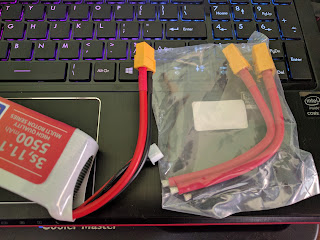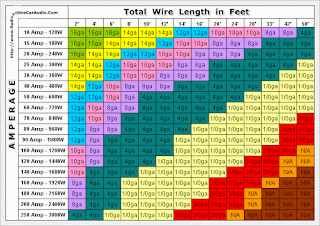When we are building RC models (aircrafts, multicopters etc.), something we typically overlook is what type of wires to use to distribute power in them. Usually, we try to reduce the weight of the model, so we tend to go with smaller wires.
But, we cant expect to put in small circuit-wires and have them handle the amount of power needed.
If you look at the wires that comes in the output leads of a Li-Po, or the wires that comes on a standard XT Jack, you'll notice that they're quite huge.
These need to be huge to handle the amount of amperage that goes through them.
So, we should also consider the amperage, and the length of wire needed when selecting the size (gauge) of the wires.
A normal brushless motor might draw about 10 - 20 Amperes of power. In the case of a multicopter, the total power needed is proportional to the number of motors. So, if you have 6 motors, that's 120 Amps minimum the fires coming from the battery needs to handle.
Trying to calculate the size needed ourselves can be bit tricky. But lucky for us, there are pre-calculated charts available which we can use.
Based on the chart, and details from here, the general guidelines for wire gauge is as follows,
(source)
So, make sure you get some heavy-duty wire for your RC models.
Related Links:
http://forum.flitetest.com/showthread.php?16177-Multirotor-wire-gauges
https://www.rcgroups.com/forums/showthread.php?2132883-Typical-wire-gauge-for-connecting-ESCs-Motors-Batteries
https://oscarliang.com/wire-awg-chart-quadcopter-rc/
But, we cant expect to put in small circuit-wires and have them handle the amount of power needed.
If you look at the wires that comes in the output leads of a Li-Po, or the wires that comes on a standard XT Jack, you'll notice that they're quite huge.
 |
| Large gauge wires on a Li-Po and XT connectors |
These need to be huge to handle the amount of amperage that goes through them.
So, we should also consider the amperage, and the length of wire needed when selecting the size (gauge) of the wires.
A normal brushless motor might draw about 10 - 20 Amperes of power. In the case of a multicopter, the total power needed is proportional to the number of motors. So, if you have 6 motors, that's 120 Amps minimum the fires coming from the battery needs to handle.
Trying to calculate the size needed ourselves can be bit tricky. But lucky for us, there are pre-calculated charts available which we can use.
 |
| Wire Gauge chart for Amperage and Length - image from here |
Based on the chart, and details from here, the general guidelines for wire gauge is as follows,
- 13AWG Wire - 130A
- 14AWG Wire - 110A
- 16AWG Wire - 70A
- 18AWG Wire - 45A
- 20AWG Wire - 27A
- 22AWG Wire - 17A
(source)
So, make sure you get some heavy-duty wire for your RC models.
Related Links:
http://forum.flitetest.com/showthread.php?16177-Multirotor-wire-gauges
https://www.rcgroups.com/forums/showthread.php?2132883-Typical-wire-gauge-for-connecting-ESCs-Motors-Batteries
https://oscarliang.com/wire-awg-chart-quadcopter-rc/
Comments
Post a Comment